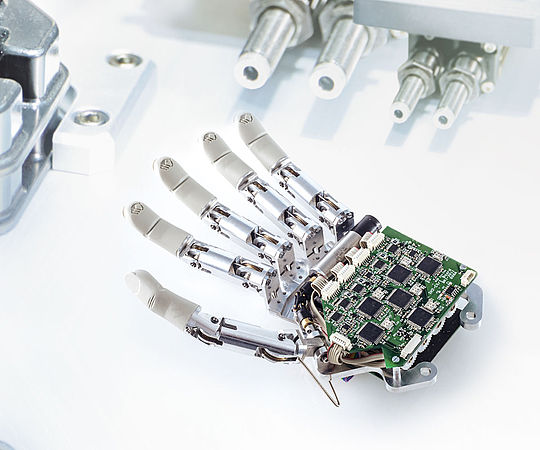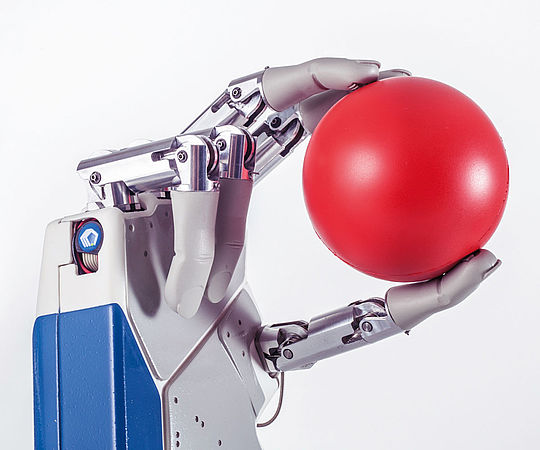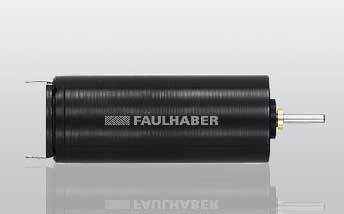 |
| May 19, 2015 | Volume 11 Issue 19 |
Designfax weekly eMagazine
Archives
Partners
Manufacturing Center
Product Spotlight
Modern Applications News
Metalworking Ideas For
Today's Job Shops
Tooling and Production
Strategies for large
metalworking plants
Small motors power bionic hand prosthesis
DC micro motors help give users natural feeling.
Grasping with suitable pressure without damaging or dropping objects, and touching and feeling the shape and texture of something: Healthy people do this hundreds of times each day without having to consider it. However, these movements embody a complex sequence. Artificially reproducing this sequence mounts a real challenge, which a team of researchers has successfully mastered with the LifeHand 2 project -- supported by micro motors from FAULHABER.

Prosthetics with disadvantages
If one follows the sports competitions for disabled persons, such as the Paralympics, it is amazing to see the level that prosthetics have attained these days. For example, in the summer of 2014 the German long jumper Markus Rehm was not allowed to travel to the European Athletics Championships because the German association was afraid that, with his carbon leg prosthesis, he would have an advantage in competing against non-disabled sportsmen.
And yet the sophisticated prosthetics made of carbon and other materials have a decisive disadvantage: The bearer cannot truly use them just the same as he would the missing body part. The hand prostheses available on the market detect muscular movements in the residual limb somewhat, and enable the bearer to open and close the hand as well as to grasp objects. But without any sensory feedback to the nervous system, the bearer cannot feel what he is attempting to grasp and must therefore keep an eye on his prosthesis so that he does not crush the objects.
Comparable with a natural hand
A major step forward was achieved with the LifeHand 2 project. The artificial hand makes fascinating things possible for the bearer: He can grasp objects with suitable pressure and, via contact sensors, feel which attributes they have. The bearer can even feel which exact fingers have contact with the object. The size and the weight of the prosthesis are also comparable with those of a natural hand.
LifeHand 2 is equipped with sensors that register tactile sensations by measuring the tension in the artificial tendons and controlling the finger movements. These data are then transformed into electrical signals that are then transmitted to the nerves. This is made possible through electrodes to the nerve fibers, which convey signals to the bearer's brain. A computer translates the signals from the sensors into pulses that the nerves can interpret. They are further transmitted via electrodes to the median nerve (nervus medianus) and the ulnar nerve (nervus ulnaris).
An international research team developed the bionic hand prosthesis at the Ecole Polytechnique Federale de Lausanne (EPFL). Six research institutes in Italy, Switzerland, and Germany were involved. Professor Silvestro Micera and his team from the Scuola Superiore Sant'Anna (SSSA) in Italy developed the sensory feedback system, and now a patient can feel something again when touching and moving objects.

In February 2013, a prototype of the LifeHand 2 was tested in the Gemelli hospital in Rome within the scope of a clinical study supervised by Paolo Maria Rossini. A Danish man named Dennis Aabo Sorensen volunteered to be the first person to test the LifeHand 2. Nine years before, Sorensen had lost his left hand in an accident.
Four microscopic interfaces were grafted onto the main nerves of Sorensen's left arm. After the electrodes had been surgically implanted and the wounds had healed, the prosthesis was connected. When Sorensen touched objects, the sensors of the prosthesis generated signals that were processed by a computer and relayed through a stimulator to the electrodes implanted in the nerves and, ultimately, to his brain. This all took place in less than 100 milliseconds.
With such minimum time intervals, human beings don't sense any delay in transmission. Sorensen was able to recognize the shape, consistency, and position of objects in real time and use this information in order to grasp the objects with the proper grip and appropriate application of force by controlling his fingers.
The research team was surprised just how quickly Sorensen was able to control the prosthesis. For the tests, the researchers blindfolded Sorensen and then asked him to pick up objects using the LifeHand. He succeeded in not only controlling the strength of his grip, but also in describing the shape and texture of the objects -- despite not seeing them.
 Sophisticated motors from FAULHABER
Sophisticated motors from FAULHABER
The finely detailed workmanship that the LifeHand thumb and fingers put into effect are implemented with DC micro motors from FAULHABER. With a motor diameter of 13 mm and a motor length of 31 mm, the motors are lightweight and compact. A unique aspect of the FAULHABER DC motors is their rotor, which is not wound around an iron core, but instead consists of a copper coil manufactured with a self-supporting, skew-wound design. The FAULHABER rotor has also proven itself convincingly in the Lifehand project with its extremely low inertia torque and cogging-free running properties.
For more applications similar to this one, visit the Medical and Lab Automation applications page. To learn more about innovative designs and motion solutions from MICROMO and FAULHABER, contact a member of the MICROMO team today.
Source: MICROMO
Published May 2015
Rate this article
View our terms of use and privacy policy
